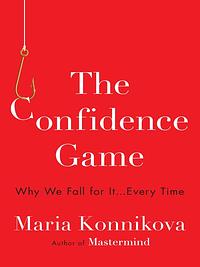Take a photo of a barcode or cover
This was absolutely fascinating. I loved seeing the science and psychology behind what makes some people con artists. Our own human nature is against us. After reading this, I just figure I'll be conned any day now.
Maybe I already have been, and I just didn't know it. Some of the cons people fell for were absolutely ridiculous, but the author explains how all the small things can lead up to something massive (and massively crazy). I wish I had written down all the other books she referenced so I can read those as well, not that I have time right now.
Maybe I already have been, and I just didn't know it. Some of the cons people fell for were absolutely ridiculous, but the author explains how all the small things can lead up to something massive (and massively crazy). I wish I had written down all the other books she referenced so I can read those as well, not that I have time right now.
challenging
informative
inspiring
reflective
medium-paced
informative
medium-paced
While I normally enjoy stories like these, this book disappointed. Konnikova set it up as an analysis as to why we fall for cons so much. Each chapter purported to either describe a different type of con or a different reason why people fall for cons. However, so many of the example stories that she devoted so much ink towards simply told the stories of successful cons. After a few chapters it became repetitive and something that I just skimmed to get to the end and on to the next book.
Awesome book! It's no wonder that a book about cons start off... unintentionally describing a certain political party led by a known con man himself. But the book never mentions his name. It doesn't have to. The book tells you how cons work. You're left to piece together the con artists you know, the people you know who have been conned, and the cons you have fallen for.
Yes, I've been conned. I've also worked for a place that used A LOT of these techniques, and all I can say is that it's good to know how cons work, so they can be used (less) on you.
Yes, I've been conned. I've also worked for a place that used A LOT of these techniques, and all I can say is that it's good to know how cons work, so they can be used (less) on you.
informative
medium-paced
emotional
funny
informative
medium-paced
Maybe my expectations were to high, but the book is more a history of a number of confidence (wo)men pulling their tricks, and less a clear breakdown of what is going on in these encounters.
I found there was too much story, with too many repetitions, and not enough clearly outlined methods of the game. - I would have hoped for more structure, and have the con-games for illustrations. In the book, the history of the con took centre stage (fun reads, admittedly), but trying to find the meat (the psychology) one has to re-read the whole thing.
I found there was too much story, with too many repetitions, and not enough clearly outlined methods of the game. - I would have hoped for more structure, and have the con-games for illustrations. In the book, the history of the con took centre stage (fun reads, admittedly), but trying to find the meat (the psychology) one has to re-read the whole thing.
Konnikova blends stories with facts, allowing readers to understand the ins and outs of con (wo)men and the con itself. By walking readers through the different facets of the con game, she demonstrates not only how con (wo)men work but also our openness as victims to be conned (some more than others). Overall, Konnikova shows us that we are all con men to a degree, but where most of us fumble through unwittingly, some make it an art. It is those few that we should be aware of, and Konnikova's explanations of how they work can let readers be more prepared to combat cons in their lives - so long as we don't become overly confident!
Some of my favorite stories center around con-men -- people who find a way to take advantage of others. In the movies this is generally robbing from the rich, but back here in reality this is people praying on the weak. This book is half history lesson of scams, and half analysis of them. The constraints and structure of a con is explored and deconstructed many times over, evaluating cons of different types.
I wanted to like this more, but I found it difficult to engage. The organization of chapters by parts of the con was not well-executed. As someone who is not an expert, the names of the parts of the con are not meaningful to me. Also, skipping among different incidents requires a lot more scaffolding for the reader (see Moneyball for a good example).





